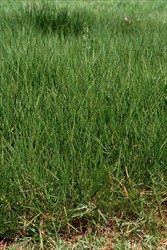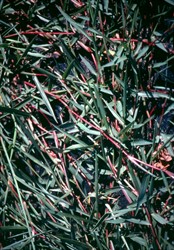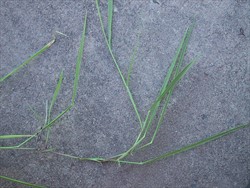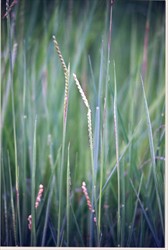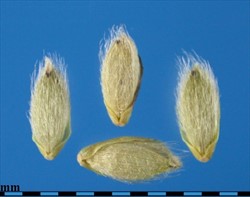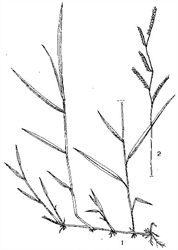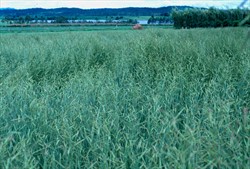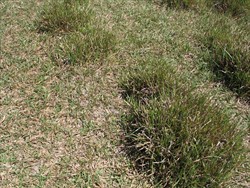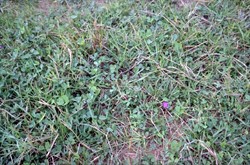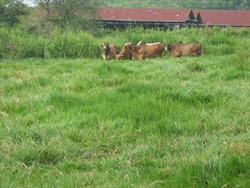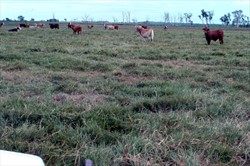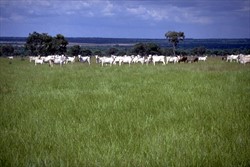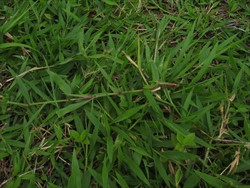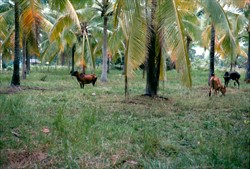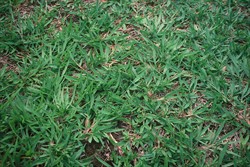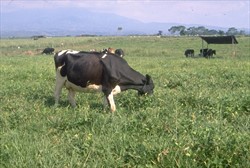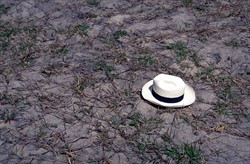Urochloa humidicola
Tropical Forages
Urochloa humidicola (Rendle) Morrone & Zuloaga
Basionym: Panicum humidicola Rendle; Brachiaria humidicola (Rendle) Schweick.
Family: Poaceae (alt. Gramineae) subfamily: Panicoideae tribe: Paniceae subtribe: Melinidinae.
A strongly stoloniferous perennial grass, forming a dense ground cover. Vegetative culms prostrate or arched, often red in colour, rooting from lower nodes; flowering culms geniculately ascending to erect, 20–60 cm high. Leaf blades linear or lanceolate, flat, 3–10 (‒16) mm wide, 4‒12 (‒25) cm long, glabrous or sparsely hairy with thickened margins, apex attenuate; ligule a fringe of short hairs; sheath bluntly keeled, the lower spreading away from the culm. Inflorescence a panicle comprising 2–3 (‒5) racemes 2–5 (‒7) cm long borne along one side of the central axis (2‒) 7–13 cm long; rachis narrow, wingless or narrowly winged, angled, hairy, wavy. Spikelets 4–6 mm long, hairy, arranged in 2 rows along each side of the rachis, falling entire. Glumes similar, reaching apex of florets, thinner than fertile lemma; lower glume oblong, > ⅔ of spikelet length, membranous, without keels, 11-veined, surface glabrous or pubescent, apex obtuse; upper glume oblong, 1 length of spikelet, membranous, without keels, 5–9-veined, surface glabrous or pubescent, apex obtuse. Basal sterile floret male, lemma similar to upper glume, oblong, 1 length of spikelet, membranous, 5-veined with cross-veins, glabrous or pubescent, obtuse; fertile lemma elliptic, 3.5–5.5 mm long, indurate, without keel, surface papillose, margins involute, apex obtuse or acute; palea involute, indurate, without keels. Approximately 200,000 seeds per kg.
Similar species
U. humidicola: Stolons present. Leaf-blades 4–20 cm long; 3–10 mm wide. Racemes 2–3 (–4), 2–7 cm long. Central inflorescence axis 2–13 cm long, rachis wingless or narrowly winged. Lower glume surface glabrous or pubescent, apex obtuse; upper glume 5–9-veined, surface glabrous or pubescent; lemma of lower sterile floret glabrous or pubescent, obtuse; fertile lemma apex obtuse or acute.
U. dictyoneura (Fig. & De Not.) Veldkamp: Stolons absent, rhizomatous. Leaf-blades 5–30 cm long, 3–10 (–30) mm wide. Racemes 3–8 (–12), 1–8 cm long. Central inflorescence axis 5–25 cm long, rachis narrowly winged. Lower glume surface pubescent, apex obtuse or acute; upper glume 7–9-veined, surface pubescent; lemma of lower sterile floret pubescent, obtuse; fertile lemma apex obtuse or apiculate. Cv. Llanero was known as U. dictyoneura for many years, having been introduced to South America from Australia under that name in the 1980s.
Africa: interere (Fula, Nigeria)
Asia: rumput beha (Indonesia); ya humidicola (Thailand)
English: Amazonian kikuyu grass, chetumal grass, chomo grass, creeping signal grass, Koronivia grass, false creeping paspalum, needle grass, sweet grass
Latin America: capim agulhao, pontudinho, quicuio da Amazônia (Brazil); braquiaria dulce, humidicola, kikuyo de la Amazonía, paspalum falso rastrero, pasto aguja, pasto Chetumal, pasto dulce, pasto humidicola, pasto puntudo (Spanish)
Native:
Africa: Angola, Botswana, Democratic Republic of the Congo, Ethiopia, Kenya, Malawi, Mozambique, Namibia (n.), Nigeria (n.), South Africa (KwaZulu-Natal, Transvaal), Sudan, Tanzania, Zambia, Zimbabwe
Cultivated/naturalized:
Asia: Indonesia, Laos, Malaysia, Thailand
Australasia/Pacific: Australia, Fiji, French Polynesia (Marquesas Islands, Society Islands), New Caledonia, Samoa, Solomon Islands
Caribbean: Puerto Rico, Trinidad and Tobago
South America: Brazil, Colombia, Ecuador, French Guiana
Forage
Mainly used for permanent pasture for grazing; can be conserved as hay or silage, but should be cut when young.
Environment
Creates an excellent, durable ground cover, which finds application in erosion suppression and weed control. Good nematode control. High biological nitrification inhibition (BNI) in the root zone of some genotypes can reduce nitrogen losses in agricultural systems.
Soil requirements
U. humidicola has been collected growing on a wide range of soils, pH 4.0–7. In cultivation, it has been grown successfully in soils with pH as low as 3.5 (acid sulfate soil) and high Al+++ saturation, and textures from sands to heavy cracking clays. It has even grown on coralline sands (pH 8.5), although may be subject to iron chlorosis with the high pH. While it grows well in infertile soils with low P levels, it responds strongly to N and P applications, particularly N. Has a low Ca requirement.
Moisture
In the native range, annual rainfall varies from 600 to 2,800 mm, but because of the associated high elevation (600–2,400 m asl) rainfall is more effective than similar amounts in lowland environments. The lower rainfall limit may be misleading since it is mostly found in seasonally swampy grasslands (Tte name "humidicola" means "moisture-loving"). In cultivation, U. humidicola is usually established in areas with a reasonably well-distributed annual rainfall of 1,000–4,000 mm, although tends to be less vigorous in environments with <1,600 mm rainfall and >6 months dry season. It remains green during moderately dry seasons, and while it turns to a reddish colour under more extreme dry conditions, it usually survives. It is better-adapted to poor drainage and short-term flooding than is U. decumbens.
Temperature
Its native range extends from the upland equatorial tropics at altitudes of up to 2,400 m asl to middle altitude (1,500 m asl) and lowland subtropics of southern Africa, a latitudinal range from about 14º30' N in the Sudan to about 30º S in South Africa. In cultivation, U. humidicola is mostly considered to be a grass for tropical lowland environments, but can extend to 1,000 m altitude and can be found in lowlands at latitudes up to 27º. Produces less cool season growth, but more hot season growth than U. decumbens. Tops killed by frost but plants recover from stolons.
Light
Grows best in full sunlight but has moderate shade-tolerance (e.g. as under mature coconut). Less shade tolerant than U. subquadripara and Stenotaphrum secundatum.
Reproductive development
Field data from Australia, Brazil and Vanuatu suggest that U. humidicola is a long-day plant, flowering into mid-summer and only flowering strongly at latitudes >10º. However, some publications suggest that it is day-neutral, or even short-day in photoperiod response.
Defoliation
Performs best under moderate to heavy grazing pressure due to its strongly stoloniferous growth habit, maintaining good ground cover even under very heavy grazing. Under light grazing, the dense mat of decumbent leaves and stems, associated with humid conditions, forms a bulk of low quality herbage. It can tolerate heavy wet-season grazing on poorly-drained soils where U. decumbens and Megathyrsus maximus will not persist.
Fire
U. humidicola is not often burned because frequent heavy grazing and humid climate reduce the chance of a build up of dry fuel. However, it recovers well from accidental fire.
Guidelines for establishment and management of sown forages.
Establishment
U. humidicola is readily established vegetatively or from seed. It is favoured by many smallholders because it establishes reliably and spreads rapidly from stem cuttings planted at 1 m × 1 m spacings. Larger areas can be planted by spreading stolons over cultivated soil and lightly incorporating with disc harrows. Seed can be used for larger commercial plantings. Seed may be dormant for 6 months or more after harvest and should be stored or acid-scarified before planting. Seed quality declines rapidly if seed is stored in hot, humid conditions, and poor seed quality has been the cause of many establishment failures. Seed is broadcast at 2–8 kg/ha (depending on germination percentage) onto a well-prepared seedbed and lightly harrowed. 'Tully' is sometimes sown in mixture with 'Llanero', the former surviving declining soil fertility better than the latter.
Fertilizer
U. humidicola is well adapted to infertile soils but responds well to N and P fertilizer.
Compatibility (with other species)
U. humidicola is very aggressive. Its ability to spread rapidly and to form a dense bulk of herbage under light or no grazing prevents other species invading. This may also be related to its ability to inhibit nitrification. It is thus very useful for establishing a pasture in the humid tropics because it prevents the normal explosion of broad-leaved weeds. For the same reason, it is not compatible with most forage legumes, but can combine well with creeping legumes under moderate to high grazing pressures.
U. humidicola can be planted under coconut palms. However, dense ungrazed grass can tie up soil nitrogen turning young palms chlorotic.
Companion species
Grasses: Not normally sown with other grasses.
Legumes: Arachis spp., Grona heterophylla, G. heterocarpa subsp. ovalifolia. Combines well with Trifolium semipilosum and Listia bainesii in Zimbabwe.
Pests and diseases
Tolerant of, but not truly resistant to spittlebugs (Aeneolamia spp., Deois spp. and Zulia spp.); more tolerant than B. decumbens and recovers quickly making it useful in parts of South America, but can be severely attacked in the humid tropics of Brazil. In Brazil, accession IRI 409 favours spittlebug multiplication. Highly resistant to leaf-cutting ants (Acromyrmex spp. and Atta spp.), but can be severely attacked by striped grass worm (Mocis latipes).
A leaf rust (Uromyces setariae-italicae), introduced from Africa, has attacked U. humidicola in Brazil, Colombia, Peru and Ecuador, and can lead to 100% loss of yield.
Ability to spread
Rarely naturalizes from spread by seed but will spread well over short distances by stolons.
Weed potential
Can invade and then dominate multi-species forages. Like many grasses, it has the potential to colonize disturbed sites, although its spread is predominantly from stolons and therefore slow.
Nutritive value
Although the leaf appears hard and fibrous, nutritional value is good (5–17% CP) considering the low fertility of the soils in which it is often grown. In the Colombian savanna, 6-week old foliage in a 54-accession collection had 5.2–8.5% CP concentration in the rainy and 3.3–9.3% in the dry season; IVDMD was 59–66% and 51–67%, respectively. Lower quality than U. decumbens, U. brizantha or U. ruziziensis. Digestibility declines quickly if not grazed.
Palatability/acceptability
Only moderately palatable in comparison to many softer grasses, but readily eaten by cattle when kept short and leafy. Palatability of U. humidicola growing on acid-infertile soils can be low, as the leaf blade becomes fibrous and strongly pigmented with anthocyanin. In Malaysia, sheep grazing koronivia grass growing on acid-infertile soils received facial lacerations from the sharp leaf tips of the fibrous leaf blades, leading to patch grazing and the requirement for regular slashing. Renowned as palatable to horses, but acceptance is variable, some horses grazing green feed and/or hay readily, others eating green feed only, hay only, or sometimes neither. It is more readily grazed by cattle and buffalo following light application of N fertilizer (25–50 kg/ha N).
Toxicity
Photosensitization has been recorded in horses grazing U. humidicola pasture for over 5 months, but is not common. Its low Ca concentration and high levels of oxalate may induce ‘big head’ disease (parathyroidism) in horses, a condition that can be overcome by feeding appropriate mineral supplements.
Feedipedia link
Dry matter
DM production is strongly influenced by soil fertility. In Fiji, annual DM yield increased linearly from 11 t/ha DM without nitrogen to 34 t/ha with the application of 450 kg/ha N. In humid-tropical Vanuatu, annual yield declined from 28 t/ha DM to 17 t/ha DM as fertility declined. Annual DM yields of 7 t/ha and 5–9 t/ha were reported from Paraguay and Brazil, respectively.
Animal production
In Colombian savannas, LWGs of 80 kg/head/yr and 240 kg/ha/yr from pure swards increased to 134 kg/head and 402 kg/ha/yr when grown with Arachis pintoi. In humid tropics of Ecuador, pure stands, grazed at 2 head/ha gave LWGs of 0.56 kg/head/day and 406 kg/ha/yr. In humid tropics of Peru, with A. pintoi, at 4 head/ha, LWGs were 0.43 kg/head/day and 692 kg/ha/yr. In Panama, pure stands grazed at 4 head/ha gave LWGs of 0.32 kg/head/day and 501 kg/ha/yr while with Neustanthus phaseoloides, the corresponding LWGs were 0.38 kg/head/day and 585 kg/ha/yr. In humid tropical Vanuatu, steers grazing koronivia/legume pastures gained 0.74, 0.68 and 0.55 kg/head/day at stocking rates of 2, 2.5 and 3.5 head/ha, respectively, over a two-year period.
U. humidicola is an aposporous pseudogamus apomict, with both hexaploid (2n = 6x = 36; sexual & apomictic) and nonaploid (2n = 9x = 54; apomictic) biotypes. Separate intraspecific U. humidicola breeding programs have been established at CIAT and Embrapa following the discovery of a naturally occurring sexual hexaploid accession (CIAT 26146), that could be crossed with apomictic hexaploid U. humidicola pollen donors.
Seed can be hand harvested, stooked and threshed, or direct headed. Yields of 290 kg/ha pure seed have been recorded in hand harvested experimental plots in Colombia, and of 80–500 kg/ha in Brazil. In tropical Australia, commercial yields of 200 kg/ha are typical with direct machine heading, but experimental yields can exceed 500 kg/ha. The large seed may remain dormant for up to 9 months, and must be stored at low temperature and low humidity to prevent seed quality decline, which can be severe. There is very limited flowering and seed production at low latitudes.
Spraying with glyphosate (3 L/ha of 36% a.i.) gives sufficient control to establish a pasture legume.
- Adapted to low fertility soils.
- Easy establishment and rapid spread from cuttings.
- Excellent ability to suppress weeds.
- Maintains good ground cover under heavy grazing.
- Some tolerance of spittlebugs.
- High LWGs per ha because of supporting high stocking rates.
- Can be unpalatable to stock, particularly sheep.
- Difficult to maintain companion legume.
- Needs frequent grazing/cutting to maintain quality.
- Susceptible to rust.
- Lower quality than other Urochloa spp.
Bogdan, A.V. (1977) Tropical Pasture and Fodder Plants. Longman Inc., New York, USA. p. 57–58.
Chippindall, L.K.A. (1955) A guide to the identification of grasses in South Africa. In: Meredith, D. (ed) The Grasses and Pastures of South Africa. Central News Agency, Johannesburg, South Africa.
Chippindall, L.K.A. and Crook, A.O. (1976) Brachiaria humidicola (Rendle) Schweick. Vol. 1 Part 126, in 240 Grasses of Southern Africa. M.O. Collins (Pvt) Ltd., Salisbury, Rhodesia
CIAT. (1992) Pastures for the tropical lowlands: CIAT’s contribution. International Center for Tropical Agriculture (CIAT), Cali, Colombia. hdl.handle.net/10568/54510
Jungmann, L., Vigna, B.B.Z., Boldrini, K.R., Sousa, A.C.B., Valle, C.B. do, Resende, R.M.S., Pagliarini, M.S., Zucchi, M.I. and Souza, A.P. de. (2010) Genetic diversity and population structure analysis of the tropical pasture grass Brachiaria humidicola based on microsatellites, cytogenetics, morphological traits, and geographical origin. Genome 53:698–709. doi.org/10.1139/G10-055
Lenné, J.M. and Trutmann, P. (eds). (1994) Diseases of Tropical Pasture Plants. CAB International, Wallingford, Oxon, UK.
Miles, J.W., Maass, B.L. and Valle, C.B. do (eds). (1996) Brachiaria: Biology, Agronomy, and Improvement. CIAT, Cali, Colombia. hdl.handle.net/10568/54362
Nuñez, J., Arévalo, A., Karwat, H., Egenolf, K., Miles, J., Chirinda, N., Cadisch, G., Rasche, F., Rao, I.M., Subbarao, G. and Arango, J. (2018) Biological nitrification inhibition activity in a soil-grown biparental population of the forage grass, Brachiaria humidicola. Plant and Soil 426:401–411. doi.org/10.1007/s11104-018-3626-5
Peters, M., Franco, L.H., Schmidt, A. and Hincapié, B. (2003) Especies forrajeras multipropósito: Opciones para productores de Centroamerica. Centro Internacional de Agricultura Tropical (CIAT), Cali, Colombia. hdl.handle.net/10568/54681
Rincón, A., Flórez, H., Ballesteros, H. and León, L.M. (2018) Efectos de la fertilización en la productividad de una pastura de Brachiaria humidicola cv. Llanero en el Piedemonte de los Llanos Orientales de Colombia. Tropical Grasslands-Forrajes Tropicales 6(1):158–168. doi.org/10.17138/tgft(6)158-168
Schultze-Kraft, R. and Teitzel, J.K. (1992) Brachiaria humidicola (Rendle) Schweick. In: Mannetje, L.’t and Jones, R.M. (eds) Plant Resources of South-East Asia No. 4. Forages. Pudoc Scientific Publishers, Wageningen, the Netherlands. p. 62–64. edepot.wur.nl/327785
Thomas, D. and Grof, B. (1986) Some pasture species for the tropical savannas of South America. III. Andropogon gayanus, Brachiaria species and Panicum maximum. Herbage Abstracts 56:557–565.
Vigna, B.B.Z., Santos, J.C.S., Jungmann, L., Valle, C.B. do, Mollinari, M., Pastina, M.M., Pagliarini, M.S., Garcia, A.A.F. and Souza, A.P. (2016) Evidence of allopolyploidy in Urochloa humidicola based on cytological analysis and genetic linkage mapping. PLoS One. 11(4):e0153764. doi.org/10.1371/journal.pone.0153764
'Llanero' Released in Colombia (1987), 'Ganadero' Venezuela (1992), 'Gualaca' Panama (1992), 'Brunca' Costa Rica (1994) (CIAT 6133, CPI 118939, BRA 001449, ILCA 12470, CPAC 3139, CNPGC 0769/86, RWS 436). Originally released as B(U). dictyoneura, but now accepted as U. humidicola. Collected in northern Zambia (10⁰9' S, 1,242 m asl, rainfall 1,100 mm). Hexaploid; similar to 'Tully' in agronomy (but initially somewhat slower stolon development) and productivity; reported to be of higher nutritive quality than 'Tully'.
'BRS Tupi' (CIAT 26149, B-084-1, BRA 005118, ILCA 14783) Released in Brazil (2013). Origin Makamba, Burundi (4⁰14' S, 1,650 masl, rainfall 1,364 mm). Hexaploid; more productive in drought conditions than 'Llanero' and 'Tully' and more even growth distribution.
CIAT 16868, CIAT 16886 Selected in Colombia for better nutritive value and seed production than existing cultivars.
UF 717 Selected in USA (Florida) and elsewhere for high yield and good salt tolerance.
